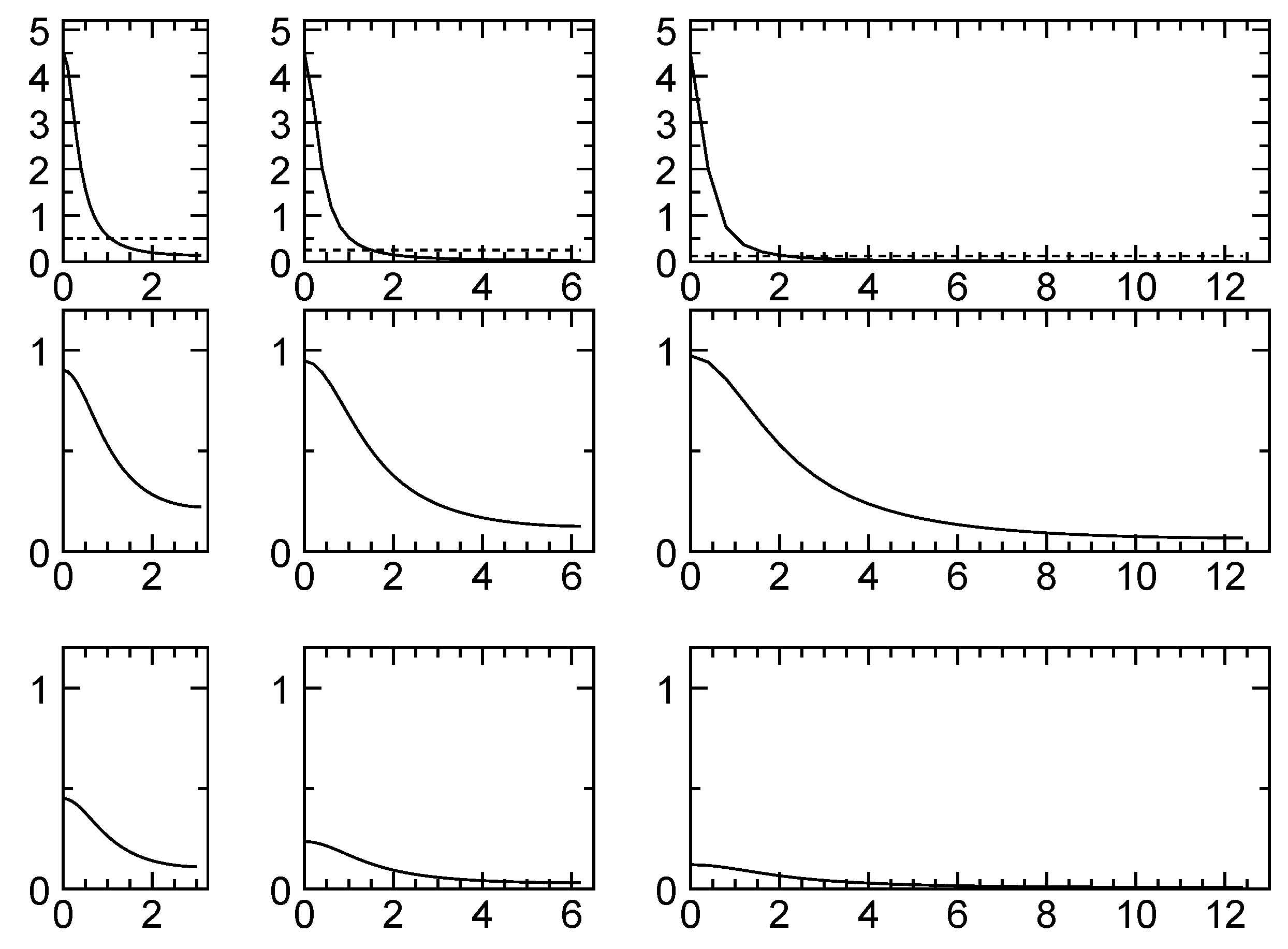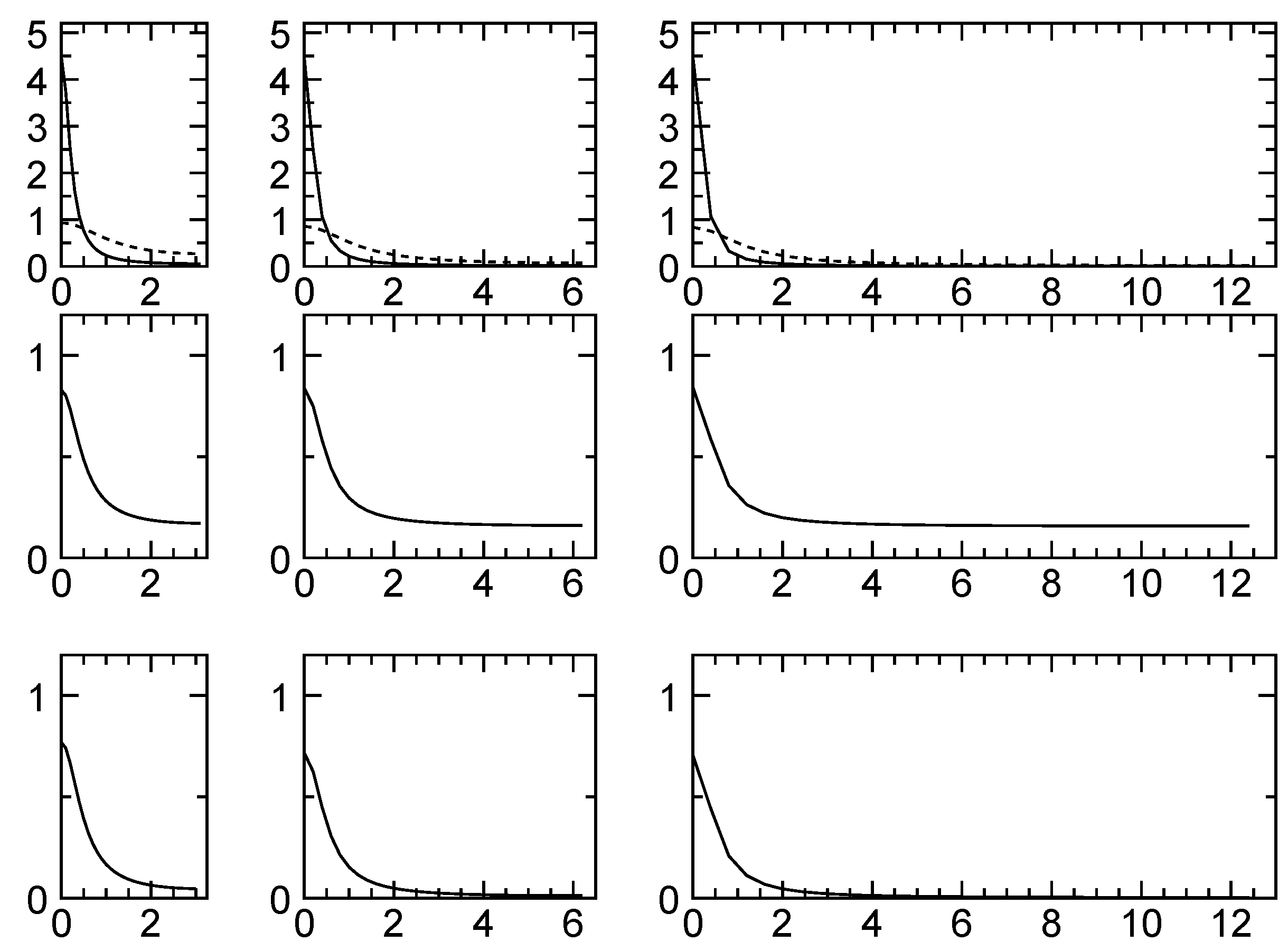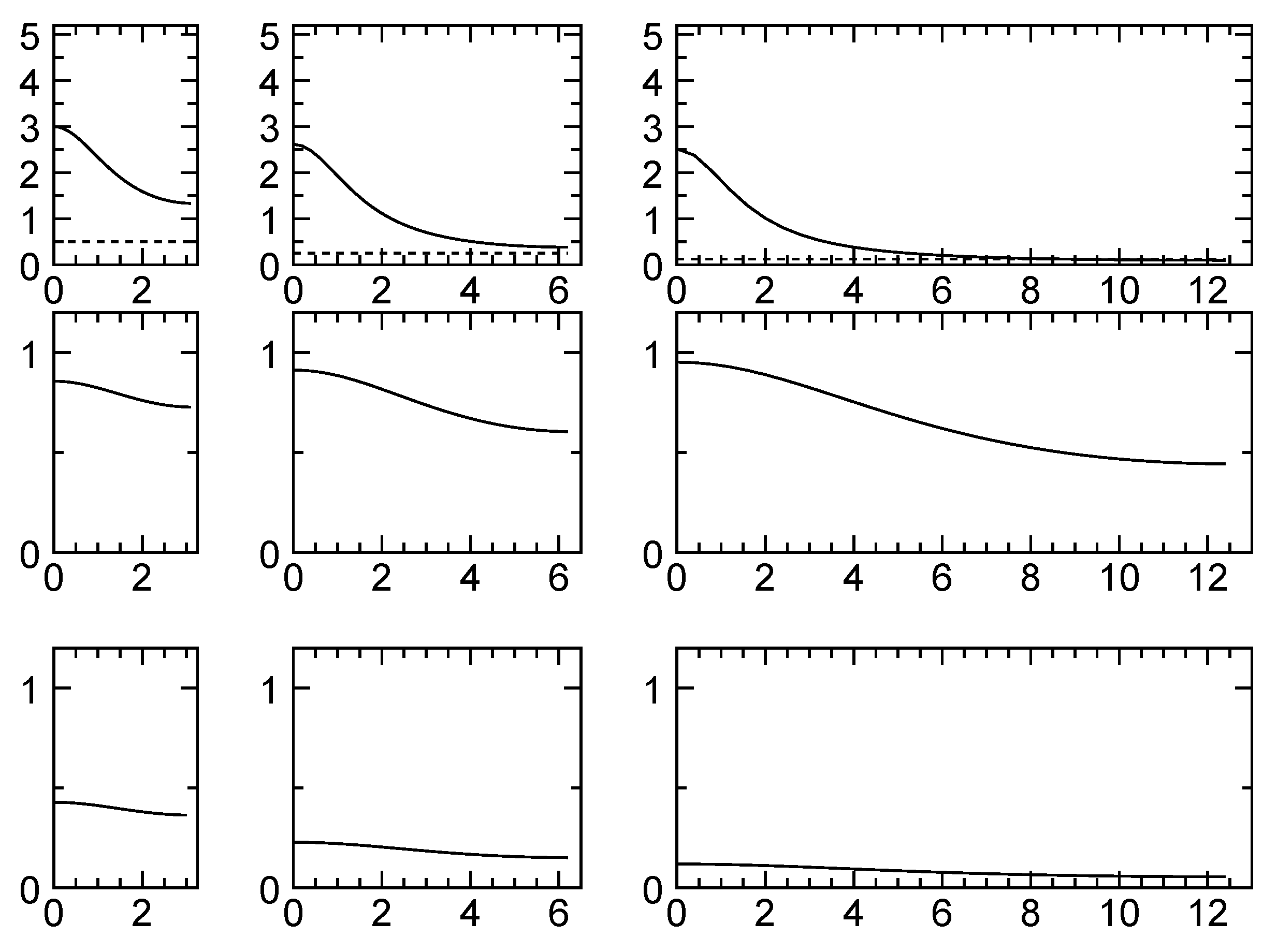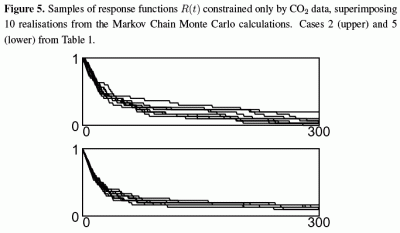Assessing the Information Content in Environmental Modelling: A Carbon Cycle Perspective
Abstract
:1. Introduction
2. Modelling
2.1. A dichotomy
- Curve Fitting :
- Build model on basis of observed correlations between putative ‘inputs’ and ‘outputs’.
- Process modelling :
- Build model on basis of ‘mechanistic’ relations between system components.
| Curve fitting | Process model | |
| For | Formalism for analysing uncertainties | Wider range of validity |
| Against | No reason to assume validity beyond domain used for calibration | Vulnerable to neglect of processes – ‘Kelvin error’ |
2.2. The modelling spectrum
| Characteristics | Example | |
| Black box: | Stochastic | Socio-economic modelling |
| empirical | ||
| Grey box: | hydrology | |
| air pollution | ||
| White box: | deterministic | aircraft control |
| – constructionist |
- ‘process models’ and ‘curve-fitting models’ are end-points of a continuum; and
- this is a useful way to think of models.
- Curve-fitting of CO2 trends, ignoring any relation to emissions.
- Assuming a constant airborne fraction, capturing the relation between concentrations and emissions to the lowest order.
- Response functions (see equation 6 below), capturing time-dependence of the functional relation between concentrations and emissions (i.e. valid over wider range and indicating that the constant airborne fraction applies for exponential growth in emissions).
- Lumped ‘Box models’, linking processes and diagnostic quantities such as the carbon isotopes: 14C and to a lesser extent 13C.
- Disaggregated boxes resolving major biomes and major ocean water masses.
- Carbon resolved at full climate model resolution and driven (where relevant) by climate model processes.
2.3. Quantifying information in models and observations
- Shannon’s ‘information’ is a measure of how much information would be obtained (on average) by observing j, given the distribution, pj . As a measure of how much information is already being conveyed by knowledge of the distribution, Lindley [16] reversed the sign, as will be done here.
- Taking the limit of Shannon’s sum in going to a continuous distribution leads to (a) a dependence on the underlying measure that defines how the limit is taken and (b) divergences, i.e. the limit is an ‘information density’ plus a term that behaves as logΔ for resolution Δ. The divergences and measure-dependence do not apply to some of the measures of relative information as noted below.
- the definition still depends on the measure of the parameter space;
- depends on z and for some z, may be negative — some observations may leave one less certain.
3. Inverse Problems
3.1. Statistics in Inverse Problems
- (i) determine given and — this is the ‘forward’ problem and it represents, in an integral form, the normal modelling activity of calculating effects given causes;
- (ii) determine given and — this is the problem of model calibration;
- (iii) determine given and — this is the problem of deducing emissions, . It is often termed ‘deconvolution’ since Equation (6) is a convolution equation.
- The number of observations.
- The number of effectively independent observations.
- The number of components needed to specify the signal.
- The number of signal components that exceed the noise level.
- The number of signal components that one is trying to estimate.
3.2. Examples from digital filtering
- Figure 1:
- Msignal < Nobs = Ndata. Increasing Ndata leads to the mean-square error decreasing as 1/Ndata due to reduced aliasing in the noise. There is also a small change associated with a shift in Ms:n due to reduction of the (initially small) aliasing of the signal. This is the case normally considered in linear regression: estimating a small number of components from a larger (usually much larger) number of independent observations.
- Figure 2:
- Ndata < Nobs and increasing Nobs leads to essentiality no change in Ndata. This shows the diminishing returns that are achieved in the case of correlated observations.
- Figure 3:
- Ndata < Msignal shows an analysis that is erroneous due to ignoring the role of truncation error. This gives a calculated value of the mean-square error that changes little with Ndata.
- Figure 4:
- Ndata < Msignal shows the same case as Figure 3 with signal aliasing now treated as a truncation error. Once this truncation error is accounted for, it can be seen that increasing Nobs reduces the mean-square-error due to reduction of truncation error.


4. A Carbon Cycle Analysis
4.1. A Model Space

- CO2 concentrations: the examples here use various combinations, from [30], of C(1990) = 353 ppm, C(1980) = 338 ppm, C(1970) = 325 ppm and C(1960) = 316 ppm.Figure 4. The effect of changing resolution on digital filtering. As for Figure 3 but with signal truncation treated as error. The data spacing in successive columns decreases by a factor of 2. Upper row shows (solid) and (dotted), middle row shows , the response of optimal filter, and bottom row shows the integrand of the mean-square error expression (12).Figure 4. The effect of changing resolution on digital filtering. As for Figure 3 but with signal truncation treated as error. The data spacing in successive columns decreases by a factor of 2. Upper row shows (solid) and (dotted), middle row shows , the response of optimal filter, and bottom row shows the integrand of the mean-square error expression (12).
- the pre-industrial concentration, C(t0). In the examples given here, a fixed value of 280 ppm was used. A more comprehensive study should allow for uncertainty in this quantity.
- A constraint on the value of R(300). A constraint of R(300) ≥ 0.1 was applied in some cases. The long-term behaviour of R(t) forms an important difference between ‘mainstream’ carbon cycle modelling and the various studies by Young and co-workers. The requirement that R(t) is of order 0.15 at long times follows from basic oceanic chemistry, combined with the requirements of conservation of mass
- A more comprehensive analysis would also consider uncertainties in the emissions, particularly those associated with changes in land use.
4.2. Results
| Case | m | Times | Range | ||||
| IS92a | |||||||
| 1 | 30 | 0.1 | 1960 | ppm | |||
| 2 | 30 | 0.0 | 1960 | ppm | |||
| 3 | 30 | 0.1 | 1990 | ppm | |||
| 4 | 30 | 0.0 | 1990 | ppm | |||
| 5 | 30 | 0.1 | 1960,70,80,90 | ppm | |||
| 6 | 30 | 0.0 | 1960,70,80,90 | ppm |
- treat the notional pre-industrial equilibrium concentration as an uncertain quantity;
- consider the uncertainties in the emissions, S(t), over the calibration period — this is particularly important for emissions from land-use change.
4.3. Extensions
- firstly, there is the extension of the analysis of the global-scale behaviour. This includes both a comprehensive exploration of the ideas outlined in the previous section and the incorporation of additional available data, most notably 14C data;
- secondly there is the extension of carbon cycle modelling to become part of more comprehensive earth system modelling.

- Air sampling networks interpreted by inverse modelling;
- Satellite data, for quantities such as leaf-area index and phenology
- Terrestrial biosphere models;
- Convective boundary layer measurements;
- Stand-level flux networks;
- Ecosystem experiments;
- Small cuvettes.
- magnitude;
- degree of correlation between components;
- temporal correlation structure;
- spatial correlation structure;
- distribution;
- mismatches in averaging;
- contribution from model representativeness error.
5. Concluding Remarks
Acknowledgements
References and Notes
- Tarantola, A. Inverse Problem Theory: Methods for Data Fitting and Model Parameter Estimation; Elsevier: Amsterdam, 1987. [Google Scholar]
- Young, P.; Garnier, H. Identification and estimation of continuous-time data-based mechanistic models for environmental systems. Environmen. Modell. Softw. 2006, 21, 1055–1072. [Google Scholar]
- Karplus, W. J. The spectrum of mathematical modelling and systems simulation. Math. Comput. Simul. 1977, 19, 3–10. [Google Scholar]
- Enting, I. G. Characterising the temporal variability of the global carbon cycle; CSIRO Atmospheric Research Technical Paper no. 40; CSIRO: Australia, 2000; http://www.dar.csiro.au/publications/enting 2000a.pdf.
- Enting, I. G. Inverse Problems in Atmospheric Constituent Transport; CUP: Cambridge, UK, 2002. [Google Scholar]
- Enting, I. G.; Wigley, T. M. L.; Heimann, M. Future emissions and concentrations of carbon dioxide: Key/ocean/atmosphere/land analyses; CSIRO Division of Atmospheric Research Technical Paper no. 31; CSIRO: Australia, 1994; http://www.dar.csiro.au/publications/enting 2001a.htm.
- Enting, I. G. Twisted: The Distorted Mathematics of Greenhouse Denial; I. Enting/Australian Mathematical Sciences Insititute: Melbourne, 2007. [Google Scholar]
- Christie, M. The Ozone Layer: A Philosophy of Science Perspective; CUP: Cambridge, U.K., 2000. [Google Scholar]
- Kellogg, W. W. Effects of Human Activities on Global Climate; Technical Note 156; WMO: Geneva, 1977. [Google Scholar]
- Gwynne, P. The cooling world. Newsweek 1975, 28 April 1975, 64. [Google Scholar]
- Young, P.; Parkinson, S.; Lees, M. Simplicity out of complexity in environmental modelling: Occam’s razor revisited. J. Appl. Statist. 1996, 23, 165–210. [Google Scholar] [CrossRef]
- Enting, I. G. A modelling spectrum for carbon cycle studies. Math. Comput. Simul. 1987, 29, 75–85. [Google Scholar] [CrossRef]
- Rayner, P. J.; Enting, I. G.; Trudinger, C. M. Optimizing the CO2 observing network for constraining sources and sinks. Tellus 1996, 48B, 433–444. [Google Scholar] [CrossRef]
- Rayner, P. J.; O’Brien, D. The utility of remotely sensed CO2 concentration data in surface source inversions. Geophys. Res. Lett. 2001, 28, 175–178. [Google Scholar] [CrossRef]
- Shannon, C. E. A mathematical theory of communication. Bell Sys. Tech. J. 1948, 27, 379–423, 623–565. [Google Scholar] [CrossRef]
- Lindley, D. V. On a measure of the information provided by an experiment. Ann. Math. Statist. 1956, 27, 986–1005. [Google Scholar] [CrossRef]
- Kullback, S.; Leibler, R. A. Information and sufficiency. Ann. Math. Statist. 1951, 22, 79–86. [Google Scholar] [CrossRef]
- Oeschger, H.; Heimann, M. Uncertainties of predictions of future atmospheric CO2 concentrations. J. Geophys. Res. 1983, 88C, 1258–1262. [Google Scholar] [CrossRef]
- Trudinger, C. M.; Enting, I. G.; Rayner, P. J.; Francey, R. J. Kalman filter analysis of ice core data. 2 Double deconvolution of CO2 and δ13C measurements. J. Geophys. Res. 2002, 107. [Google Scholar]
- Evans, S. N.; Stark, P. B. Inverse problems as statistics. Inverse Prob. 2002, 18, R55–R97. [Google Scholar] [CrossRef]
- Wunsch, C.; Minster, J.-F. Methods for box models and ocean circulation tracers: Mathematical programming and non-linear inverse theory. J. Geophys. Res. 1982, 87C, 5647–5662. [Google Scholar]
- Trampert, J.; Sneider, R. Model estimation biased by truncated expansions: Possible artifacts in seismic tomography. Science 1996, 271, 1257–1260. [Google Scholar] [CrossRef]
- Kaminski, T.; Rayner, P. J.; Heimann, M.; Enting, I. G. On aggregation errors in atmospheric transport inversions. J. Geophys. Res. 2001, 106, 4703–4715. [Google Scholar] [CrossRef]
- Gelb, A. (Ed.) Applied Optimal Estimation; MIT Press: Cambridge, Mass, 1974.
- Trudinger, C. M.; Raupach, M. R.; Rayner, P. J.; Enting, I. G. Using the Kalman filter for parameter estimation in biogeochemical models. Environmetrics 2008, (in press). [Google Scholar] [CrossRef]
- Abramowitz, G.; Gupta, H. Towards a model space and independence metric. Geophys. Res. Lett. 2008, 35, L05705. [Google Scholar] [CrossRef]
- Enting, I. G.; Mansbridge, J. V. The incompatibility of ice-core CO2 data with reconstructions of biotic CO2 sources. Tellus 1987, 39B, 318–325. [Google Scholar] [CrossRef]
- Enting, I. G. The incompatibility of ice-core CO2 data with reconstructions of biotic CO2 sources (II). The influence of CO2-fertilised growth. Tellus 1992, 44B, 23–32. [Google Scholar] [CrossRef]
- Enting, I. G. Laplace transform analysis of the carbon cycle. Environ. Modell. Softw. 2007, 22, 1488–1497. [Google Scholar] [CrossRef]
- Keeling, C. D.; Whorf, T. P. Atmospheric records from the SIO sampling network. In Trends ’93: A Compendium of Data on Global Change; Boden, T. A., Kaiser, D. P., Serpinski, R. J., Stoss, F. W., Eds.; CDIAC, ORNL: Oak Ridge, 1994. [Google Scholar]
- Broecker, W. S.; Peng, T.-H.; Engh, R. Modeling the carbon system. Radiocarbon 1980, 22, 565–598. [Google Scholar]
- Enting, I. G. Ambiguities in the calibration of carbon cycle models. Inverse Prob. 1990, 6, L39–L46. [Google Scholar] [CrossRef]
- Alley, R.; et al. Summary for Policymakers. In Climate Change 2007, The Physical Basis; Solomon, S., Qin, D., Manning, M., Chen, Z., Marquis, M., Avery, K., Tignor, M., Miller, H., Eds.; Published for the IPCC by CUP: Cambridge, UK, 2007. [Google Scholar]
- Kruijt, B.; Dolman, A. J.; Lloyd, J.; Ehleringer, J.; Raupach, M.; Finnigan, J. Assessing the regional carbon balance: Towards an integrated, multiple constraints approach. Change 2001, 56 (March– April 2001), 9–12. [Google Scholar]
- Canadell, J. G.; et al. Carbon metabolism of the terrestrial biosphere: A multitechnique approach for improved understanding. Ecosystems 2000, 3, 115–130. [Google Scholar] [CrossRef]
- Raupach, M. R.; Rayner, P. J.; Barrett, D. J.; DeFries, R. S.; Heimann, M.; Ojima, D. S.; Quegan, S.; Schmullius, C. C. Model-data synthesis in terrestrial carbon observation: methods, data requirements and data uncertainty specifications. Glob. Change Biol. 2005, 11, 378–397. [Google Scholar] [CrossRef]
- Abramowitz, G. Towards a benchmark for land surface models. Geophys. Res. Lett. 2005, 32, L22702. [Google Scholar] [CrossRef]
- Enting, I. G.; Lassey, K. R. Projections of future CO2; CSIRO Division of Atmospheric Research Technical Paper no. 27; CSIRO: Australia, 1993; http://www.dar.csiro.au/publications/enting 2000e.pdf.
© 2008 by the authors; licensee MDPI, Basel, Switzerland. This article is an open access article distributed under the terms and conditions of the Creative Commons Attribution license (http://creativecommons.org/licenses/by/3.0/).
Share and Cite
Enting, I.G. Assessing the Information Content in Environmental Modelling: A Carbon Cycle Perspective. Entropy 2008, 10, 556-575. https://doi.org/10.3390/e10040556
Enting IG. Assessing the Information Content in Environmental Modelling: A Carbon Cycle Perspective. Entropy. 2008; 10(4):556-575. https://doi.org/10.3390/e10040556
Chicago/Turabian StyleEnting, Ian G. 2008. "Assessing the Information Content in Environmental Modelling: A Carbon Cycle Perspective" Entropy 10, no. 4: 556-575. https://doi.org/10.3390/e10040556
APA StyleEnting, I. G. (2008). Assessing the Information Content in Environmental Modelling: A Carbon Cycle Perspective. Entropy, 10(4), 556-575. https://doi.org/10.3390/e10040556






